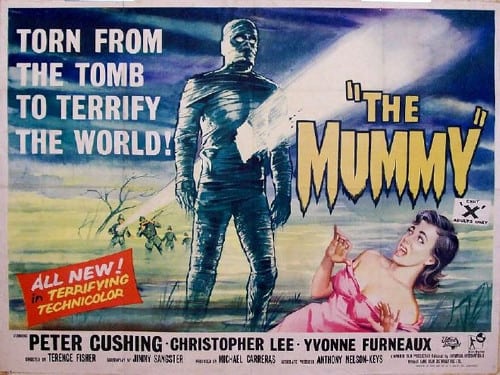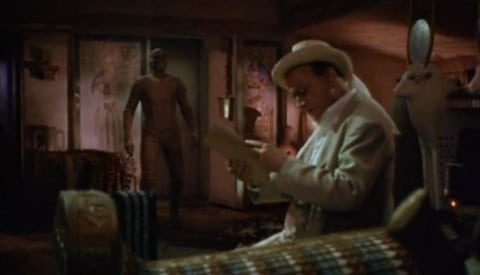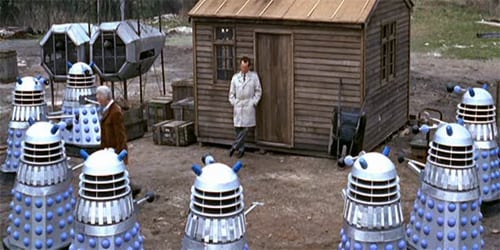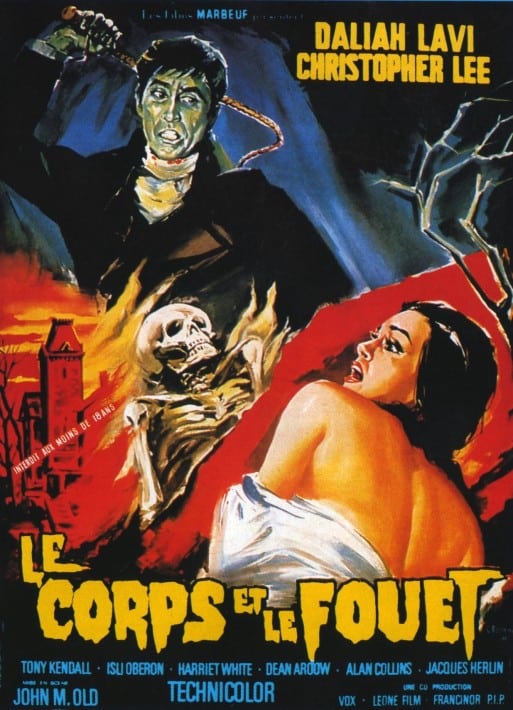The Mummy (1959)
Directed by: Terence Fisher
Written by: Jimmy Sangster
Starring: Christopher Lee, Eddie Byrne, Peter Cushing, Yvonne Furneaux
UK
AVAILABLE ON BLU-RAY AND DVD
RUNNING TIME: 86 min
REVIEWED BY: Dr Lenera, Official HCF Critic
In Egypt in 1895, archaeologists John Banning, his father Stephen and his uncle Joseph Whemple find the tomb of Princess Ananka, the high priestess of the god Karnak. John has a broken leg and cannot accompany the others when they open the tomb despite an Egyptian named Mehemet Bey warning them not to do so because of a fatal curse against desecrators. In the tomb, Stephen finds the Scroll of Life, reads from it and is found in a catatonic state. Three years later, back in England, Stephen comes out of his catatonia and tells John that, when he read from the Scroll, he revived Kharis, the mummified high priest of Karnak, who was sentenced to be entombed alive to serve as the guardian of Princess Ananka’s tomb as punishment for attempting to bring her back to life out of forbidden love. Now, Kharis will hunt down and kill all those who desecrated Ananka’s tomb….
Unlike their versions of Dracula and Frankenstein which differed a fair bit from their black and white forebearers, Hammer’s first film made in collaboration with Universal allowed them full use of the studio’s material, and is therefore quite close to the earlier movies featuring the bandaged menace, though not so much the 1932 The Mummy, from which it only really takes one scene and the odd idea. Instead, Jimmy Sangster’s script basically remakes The Mummy’s Tomb and The Mummy’s Ghost in England, though the titles rather rudely fail to credit any existing material. This means that the film doesn’t feel quite as fresh as The Curse Of Frankenstein and Dracula, but it’s still immensely entertaining and extremely well crafted, a simple revenge monster movie raised to a higher level by Hammer’s team working at full throttle and a touch of sad romanticism that adds some poignancy to the tale. Christopher Lee’s Kharis remains perhaps the screen’s greatest Mummy, an almost unstoppable juggernaut who can seemingly get in anywhere to kill you but also carries with him great pain. Saying all this though, it’s rather amusing to note that the previously ‘X’ [‘18’] certificate film is not only now given a ‘PG’ certificate [well, I guess that today’s youngsters might find bits of the Brendan Fraser actioners more disturbing] but is deemed suitable viewing by the BBC for Saturday afternoon. How things have changed!
Sangster’s script, about which the BBFC warned about the frequent throttling and the sound of bones being crunched, was revised to add the lengthy Egpytian flashback in the middle of the film, a slightly toned down [for budgetary reasons] ending, and alterations made necessary by Peter Cushing injuring his back. As posters had already been produced and released, Cushing suggested he drive a spear through Lee, causing the poster image of a torch being shone through a hole in the Mummy’s chest to make a little more sense. Lee injured himself a lot on this picture: he dislocated his shoulder when breaking down a door, was burnt and scarred by squibs, twisted his back when picking up the heroine, and injured his knees and shins while doing scenes in the studio-tank swamp because he couldn’t see where the various pipes and fittings under the water were. To create the impression that the tomb hadn’t been opened in thousands of years, cinematographer Jack Asher had somebody climb into the catwalks above the set to spray the air with water before each scene. As the water particles descended, they took all the smoke and dust with them, leaving the air completely clear. The BBFC considered an ‘A’ certificate when seeing a black and white version but changed their mind when viewing the film in colour, while alternate footage of the Egyptian maidens being topless [not shot by director Terence Fisher] and Kharis’ tongue being removed was shot for Continental markets but not used and seems to be lost now. I used to have a book on horror films which had shots of the graphic tongue scene. The film was another big hit for Hammer and even got slightly better reviews than usual.
We open in Egypt and I must say right away that the Shepperton desert set isn’t very convincing, but there’s little point in criticising a film for not having certain resources. We then get a partial recreation of the beginning scene to the 1932 The Mummy, with an archaeologist reviving the Mummy and then being found stark raving mad, though we don’t see the Mummy at all this time, and the scene lacks the creepiness of the original one [though a fuller version of the incident is shown much later on]. After a bit more time spent hanging around the tomb we switch to England and one of Hammer’s most vivid monster awakenings. After some reasonably amusing comic relief with two drunken carters, the casket containing Kharis slides into a swamp [instantly recognisable from the previous Hammer film Yesterday’s Enemy] and the next night Mehemet, who has brought Kharis to England to kill of those who have desecrated Princess Ananka’s tomb, calls upon Kharis to rise from the swamp, which he does, but very quickly, unlike most monsters who take their time with this kind of thing. Then we get what could be the film’s most frightening scene as Kharis breaks into the room containing John Banning to strangle him, ripping out the bars of the window and then climbing through it. Can you imagine Lon Chaney’s slow moving, crippled Mummy even trying to do this? This creature may be the living dead but is very agile and super strong.
It’s only now that we get the obligatory Egyptian flashback, and it’s a little long-winded if you’re not interested in Ancient Egyptian burial rights but admirably accurate in its detail. The rest of the film alternates Mummy attacks with John Banning and the disbelieving police trying to make sense of the whole thing. Lee once amusingly said, when defending Hammer’s films from criticisms of excessive violence: “In The Mummy, I only kill three people, and not in a ghastly way – I just break their necks”, though he wasn’t quite right as you also see Kharis briefly breaking a victim’s back. In general though The Mummy does feel quite restrained and doesn’t really deviate from the story as told by Universal while even being rather [probably unintentionally] reminiscent of The Curse Of Frankenstein during some of the Mummy set pieces, Lee doing a lot of the same actions, and one shot of Lee strangling someone while Cushing tries to pull him away being almost an exact duplicate of a shot from the earlier film. Rather late in the day, the script brings in the old device of a modern woman being the spitting image of Kharis’s forbidden love Ananka. The scene where Kharis stops attacking John and, slowly advancing towards John’s wife Isobel, looks at her with Lee’s expressive eyes conveying so much pain, and holds out his arms before turning and going away, is rather touching, and was this the first horror film where somebody makes themselves to look more like somebody else to distract a monster from doing his dirty work? The swamp climax, a slight variation on the one in The Mummy’s Ghost, is reasonably exciting but brings to the fore a flaw in the story which exists in many Mummy films but seems especially jarring in this one: how the hell does Kharis understand English?
Elsewhere, despite the film’s pulpy material, there’s a surprising amount of intelligence to be found in certain places. Outside of the many Mummy scenes, my favourite bit in the film is a lengthy dialogue scene, played to perfection by Cushing and George Pastell, between Mehemet and the rather snooty John which causes the viewer to almost understand the villiain’s point of view. While not trying to force you to take sides on the issue like a PC film might do today, it does criticise the Western mentality of raiding ancient tombs and removing their artifacts for the benefit of white people back home, who of course are supposedly the only ones who can properly understand and appreciate them. Meanwhile Bernard Robinson’s design work [though spot the room from The Man Who Could Cheat Death] is working at its usual high level especially concerning the quite real-looking and authentic-seeming Egyptian props, and the Mummy make-up is extremely effective [though I wasn’t sure if what I saw in a few scenes was the suit’s zipper or a deliberate part of the design]. Jack Asher’s photography, containing several quite elaborate set-ups, matches it, especially in the supposedly outdoor swamp scenes. He again indulges his love of green for some gorgeous moments inside Ananka’s tomb where the sarcophagus and its immediate surroundings are totally unrealistically bathed in the colour, and what’s all that red over the swamp in one day time scene? Who cares, it looks great!
Though pretty Yvonne Furneaux doesn’t make enough of an impression as Ananka/Isobel, the acting all-round is pretty good in this film, though, considering his career, you have to chuckle when Cushing says early on: “Seems like I’ve spent the better part of my life amongst the dead”. Michael Ripper has one of his most fun cameos as a drunken rabbit poacher who sees the Mummy but in the opinions of others has just: “Been seeing the little people again”, to which he cries: “He was ten feet tall”! Franz Reizenstein’s score is one of the best of the early Hammer horror scores to not be from James Bernard. His haunting main theme, redolent of antiquity [yet the score avoids any attempts at representation of Egyptian music] but also tragedy, sticks in the mind. It’s especially well used during the flashback where variants of it are interspersed with other material creating a lengthy piece of some strength. There’s great dramatic scoring for the Mummy scenes and nice bits of interesting orchestral colour here and there, though sometimes music plays in dialogue when it’s not necessary. I don’t think that The Mummy quite reaches the heights of Hammer’s very best work, and, while it definitely betters the 40’s Mummy films which it remakes, for me it lacks that extraordinary atmosphere and hypnotic weirdness of the 1932 Boris Karloff The Mummy which made that film so unique. It’s enormous fun though; suspenseful, exciting, and just a little bit sad, which at times is all you could want an old-school monster/horror movie to be. I remain of the hope that, when Universal begin their new version of The Mummy, they’ll refer more to this film for inspiration rather than Indiana Jones.










Be the first to comment